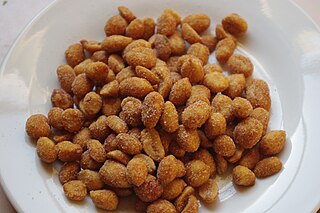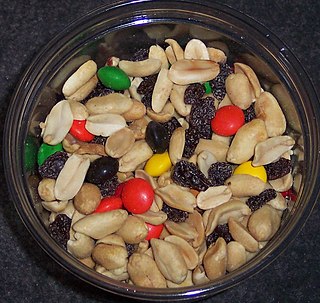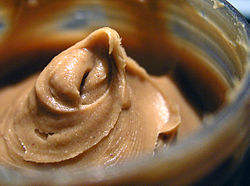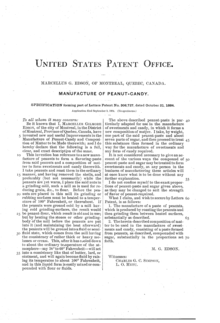
The peanut, also known as the groundnut, goober (US), pindar (US) or monkey nut (UK), is a legume crop grown mainly for its edible seeds. It is widely grown in the tropics and subtropics, important to both small and large commercial producers. It is classified as both a grain legume and, due to its high oil content, an oil crop. World annual production of shelled peanuts was 44 million tonnes in 2016, led by China with 38% of the world total. Atypically among legume crop plants, peanut pods develop underground (geocarpy) rather than above ground. With this characteristic in mind, the botanist Carl Linnaeus gave peanuts the specific epithet hypogaea, which means "under the earth".

Popcorn is a variety of corn kernel which expands and puffs up when heated; the same names also refer to the foodstuff produced by the expansion.

Planters Nut & Chocolate Company is an American snack food company now owned by Hormel Foods. Planters is best known for its processed nuts and for the Mr. Peanut icon that symbolizes them. Mr. Peanut was created by grade schooler Antonio Gentile for a 1916 contest to design the company's brand icon. The design was modified by a commercial artist and has continued to change over the years.

Boiled peanuts are popular in some places where peanuts are common. Fully mature peanuts do not make good quality boiled peanuts; rather, raw or green ones are used. Raw denotes peanuts in a semi-mature state, having achieved full size but not being fully dried, as would be needed for roasting or peanut butter use. Green denotes freshly harvested and undried peanuts that must be refrigerated. After boiling in salt water they take on a strong salty taste, becoming softer with prolonged cooking, and somewhat resembling a pea or bean, to which they are related because they are legumes and a nut only in the culinary sense.

Jif is an American brand of peanut butter made by The J.M. Smucker Company, which purchased the brand from Procter & Gamble in 2001.

Bamba is a snack made of peanut-butter-flavored puffed maize manufactured by the Osem corporation in Kiryat Gat, Israel. Bamba is one of the leading snack foods produced and sold in Israel. It was introduced in 1964. Bamba makes up 25% of the Israeli snack market.

Skippy is an American brand of peanut butter spread manufactured in the United States and China. First sold in 1932, Skippy is currently manufactured by Hormel Foods, which bought the brand from Unilever in 2013. It is the best-selling brand of peanut butter in China and second only to the J.M. Smucker Company's Jif brand worldwide.

Peanut oil, also known as groundnut oil or arachis oil, is a vegetable oil derived from peanuts. The oil usually has a mild or neutral flavor but, if made with roasted peanuts, has a stronger peanut flavor and aroma. It is often used in American, Chinese, Indian, African and Southeast Asian cuisine, both for general cooking and in the case of roasted oil, for added flavor. Peanut oil has a high smoke point relative to many other cooking oils, so it is commonly used for frying foods.

Peter Pan is an American brand of peanut butter that is marketed by Post Consumer Brands, part of Post Holdings, and is named after the J. M. Barrie character. The product was introduced by Swift & Company in 1920 under the name "E. K. Pond" and renamed in 1928.

Peanut sauce, satay sauce, bumbu kacang, sambal kacang, or pecel is an Indonesian sauce made from ground roasted or fried peanuts, widely used in Indonesian cuisine and many other dishes throughout the world.

Almond butter is a food paste made from grinding almonds into a nut butter. Almond butter may be "crunchy" or "smooth", and is generally "stir" or "no-stir" (emulsified). Almond butter may be either raw or roasted, but this describes the almonds themselves, prior to grinding.

Mixed nuts are a snack food consisting of any mixture of mechanically or manually combined nuts. Common constituents are peanuts, almonds, walnuts, Brazil nuts, cashews, hazelnuts (filberts), and pecans. Mixed nuts may be salted, roasted, cooked, or blanched.
Peanut Butter is a product of peanuts used in sauces, cookies, crackers, breakfast cereals and ice cream.
Hazelnut butter or hazelnut paste is a food spread made from crushed and blended hazelnuts. More commonly found in Europe, hazelnut butter is also familiar when mixed with chocolate as an ingredient in chocolate spreads. Hazelnut butter is available in both crunchy and smooth varieties, and can be made from either raw or roasted hazelnuts. Gianduja is also a type of chocolate stretched with hazelnut butter.

Peanut Corporation of America (PCA) was a peanut-processing business which is now defunct as a result of one of the most massive and lethal food-borne contamination events in U.S. history.

Dry roasting is a process by which heat is applied to dry foodstuffs without the use of oil or water as a carrier. Unlike other dry heat methods, dry roasting is used with foods such as nuts and seeds, in addition to some eaten insects such as house crickets. Dry-roasted foods are stirred as they are roasted to ensure even heating.

Honey-roasted peanuts is a salt-, sugar- and honey-flavored peanut snack food that is provided as a mass-produced product line by several nut and snack food companies, such as Planters, The Sun Valley Nut Co, and King Nut.
Big D is a British brand of peanuts and other snack foods primarily sold in pubs. It was introduced in 1967. The brand includes 50g packets of nuts, both carded and tumble. They are distributed within the licensed and retail trade in the UK, and also in Ireland under an agreement with the Irish snack food manufacturer Tayto. The brand's peanut varieties include salted, dry roasted, bird's eye chili and honey roasted. The brand also includes salted cashews and smoked almonds. A range of shelf keeping units are also provided for various occasions and channels of trade.

A snack is a small portion of food generally eaten between meals. A snack is often less than 200 calories, but this can vary. Snacks come in a variety of forms including packaged snack foods and other processed foods, as well as items made from fresh ingredients at home.



















